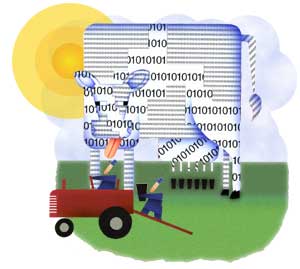|
|
|
 |
|
|
U.S.
Economy >
Agriculture |
|
From
the nation's earliest days, farming has held a crucial place in the
American economy and culture. Early in the nation's life, farmers were
seen as exemplifying economic virtues such as hard work, initiative,
and self-sufficiency. American farmers owe their ability to produce
large yields to a number of factors. The American Midwest has some of
the richest soil in the world. Rainfall is modest to abundant over most
areas of the country; rivers and underground water permit extensive
irrigation where it is not. Large capital investments and increasing
use of highly trained labor also have contributed to the success of
American agriculture. |
|
| Texts
are abridged from U.S. State Department IIP
publications and other U.S. government materials. |
|
| What
kind of information materials are available?
CD: These documents are available in fulltext format on the About the USA CD-ROM. Teachers: Request a copy for classroom use. L: Selected documents are available in German as well as other languages, including Arabic, Chinese, French, Spanish, Persian and Turkish. |
DISCLAIMER
Any reference obtained from this server to a specific commercial product, process, or service does not constitute or imply an endorsement by the United States Government of the product, process, or service, or its producer or provider. The views and opinions expressed in any referenced document do not necessarily state or reflect those of the United States Government. |

